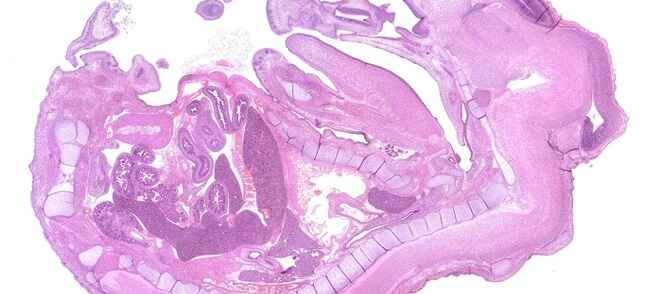- es Change Region
- Global Site
- Casa
- Aplicaciones
- Investigación clínica
- Slide Scanning
Slide Scanning

Slide scanning, also referred to as whole slide imaging, refers to the serial imaging of an entire microscope slide to create a “virtual slide” – a detailed digital version of the slide that can be easily shared and referenced in the future. Image features can be readily quantified. Slide scanning is becoming increasingly prevalent in fields such as basic life science research, pharmaceutical R&D, geology, and more.
Products for Slide Scanning
The Nikon BioPipeline SLIDE High Content Imaging System is our solution for slide scanning of large numbers of slides and for a variety of research applications. This system features a Marzhauser Slide Express 2 robotic slide loader configured on an ECLIPSE Ni-E upright motorized microscope. The BioPipeline SLIDE is completely integrated using the NIS-Elements software and available with an optional server providing an additional 200 TB of storage and a direct 10 GbE connection to the imaging workstation.
●: Incluido, ⚬: Opcional
| BioPipeline SLIDE High Content Imaging System |
|
|---|---|
| Maximum Slide Capacity | 120 |
| Automated Slide Exchange | yes |
| Transmitted Light Source | LED or Halogen |
| Auto-Focus | yes |
| Camera Integration | Customizable (color and mono camera options available) |
| Data Storage | Local Storage Dedicated Server Storage (optional) |
| Supported Contrast Techniques | BioPipeline SLIDE |
| Brightfield | yes |
| Darkfield | yes |
| Differential Interference Contrast (DIC) | yes |
| Widefield Fluorescence | yes |
| Phase Contrast | yes |
*BioPipeline SLIDE is not for clinical diagnostic use.
Discussion of Slide Scanning
Selecting a Slide Scanning System – Key Concerns
Significant progress has been made in the development and optimization of slide scanning systems. The following is a list of key questions and concerns to consider when selecting a slide scanning system for purchase:
- How many slides are you typically working with and how many can be loaded in the system at once?
- What is the required level of resolution? This will determine which objective lens should be used and thus directly influence the per slide acquisition period and total amount of data generated.
- Are motorized system components sufficiently accurate? How well are individual images combined by the software? Does tiled acquisition and image stitching introduce artifacts?
- What are the required image analysis capabilities? Certain assays may have dedicated turnkey software modules while others may require a customized analysis pipeline.
- Which contrasting technique(s) are required? Many applications require brightfield imaging. However, other applications may require a different technique, such as fluorescence.
- Is there a data management plan? How much storage capacity is required?
Further Information on Microscopy Solutions for Slide Scanning
If you’d like to learn more about solutions for slide scanning, please contact your Nikon representative.
Glosario
- Auto-Focus
- In this context, auto-focus refers to the availability of a software-based auto-focus routine that works in conjunction with the motorized stage to find the optimal in-focus Z plane, which is usually determined based on image contrast.
- Automated Slide Exchange
- Slide exchange is automatically performed by sample exchange robotics.
- Camera Integration
- Nikon provides a variety of camera options, including fast color and monochrome CMOS options.
- Data Storage
- One of the challenges of imaging entire microscope slides is ensuring adequate data storage capabilities. Single slide images can readily reach file sizes in the hundreds of MB.
- Maximum Slide Capacity
- This specifies the maximum number of slides the system can hold simultaneously.
- Supported Contrast Techniques
- Brightfield microscopy is standard for evaluation of H&E-stained slides. Depending on the application, other contrasting techniques (such as epifluorescence) may be required.
- Transmitted Light Source
- The most common types of illuminators for transmitted light (diascopic) imaging are light emitting diodes (LEDs) and halogen lamps. LEDs are bright, more energy efficient and last longer than halogen lamps.
- Casa
- Aplicaciones
- Investigación clínica
- Slide Scanning
